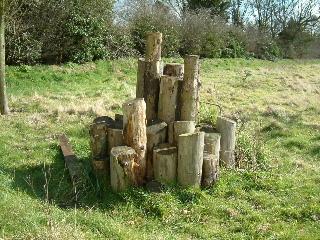
Pyramids were the brainchild of E. Tochtermann who built the first Hirschkäferwiege, stag beetle cradle, in Germany in the early 90's [1].
The idea was to find out if stag beetles would be tempted to breed in artificially built habitats that mimic the now scarce tree stumps, their favorite habitat.
The idea took over in various countries, and the first pyramid to be built in England, following this German model, was possibly the one in Highwoods Country Park, Colchester in 1998. Several years later pyramids have become a regular feature of the English countryside in stag beetle rich areas, some more pretentious than others nevertheless each with its own character.
Just see below a sample of some pyramids around Colchester, a stag beetle hot spot. The first to be built was the top one on the left. Click on the picture to see how it has aged.
 |
Furthermore in Kew gardens there is a very impressive deadwood amphitheatre decorated with a couple of stag beetle sculptures.
We very much hope that these pyramids will be a good home to not only stag beetles but to lots of other invertebrates that also feed on decaying wood. To find that out they would need to be monitored regularly.
 PS: Around Colchester they have even acquired a stylish logo which says: "A DEAD WOOD NATURE RESERVE. For more information call 01206 853588".
PS: Around Colchester they have even acquired a stylish logo which says: "A DEAD WOOD NATURE RESERVE. For more information call 01206 853588".
I have got one of those on my front garden sycamore stump. Some neighbours, with lots of stag beetle larvae in their garden, are displaying one on their fence. If you also have a good breeding colony and would like one just call the above number.
If you want to make your own visit How to build a pyramid, or How to build a lollipop.
Loggeries or log piles are much smaller constructions and very suitable for ordinary sized gardens. Just do a scaled down version of the German model.
PTES - tel: 020 7498 4533, has produced a very nice brochure entitled PTES Stag Beetle Friendly Gardening with lots of practical information on how to make them.
[1] - References:
Tochtermann, B. von E. (1987). Modell zur Artenerhaltung der Lucanidae. Allg. Forst Zeits. 8/1987: 183-184. [PDF]
Klausnitzer, B. (1995). Die Hirschkaefer,91-92, Spectrum Akademischer Verlag.
Last modified: Mon Feb 15 2016
| Main | Stag beetle conservation | Top |